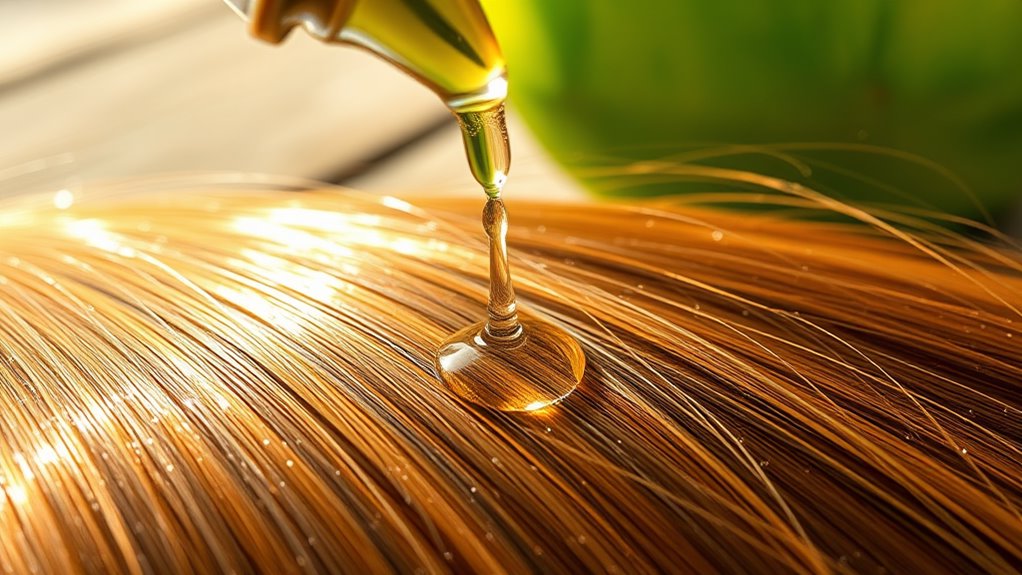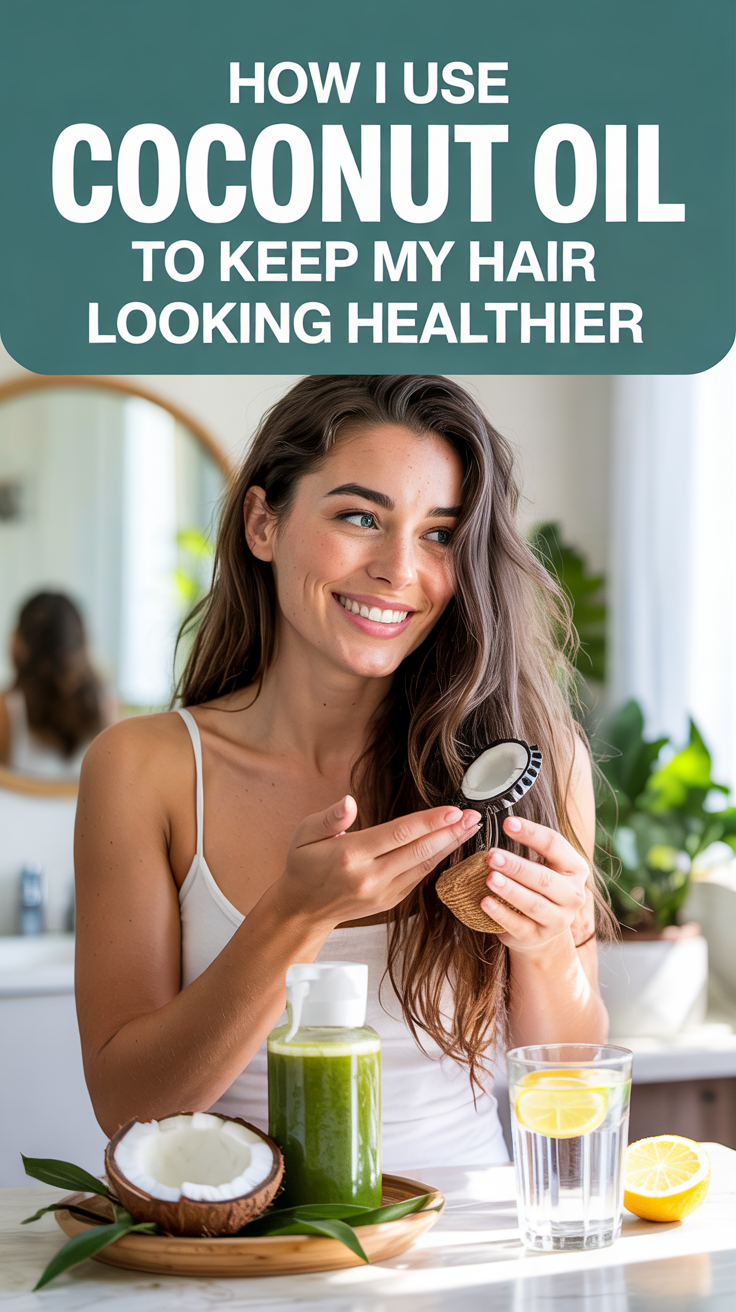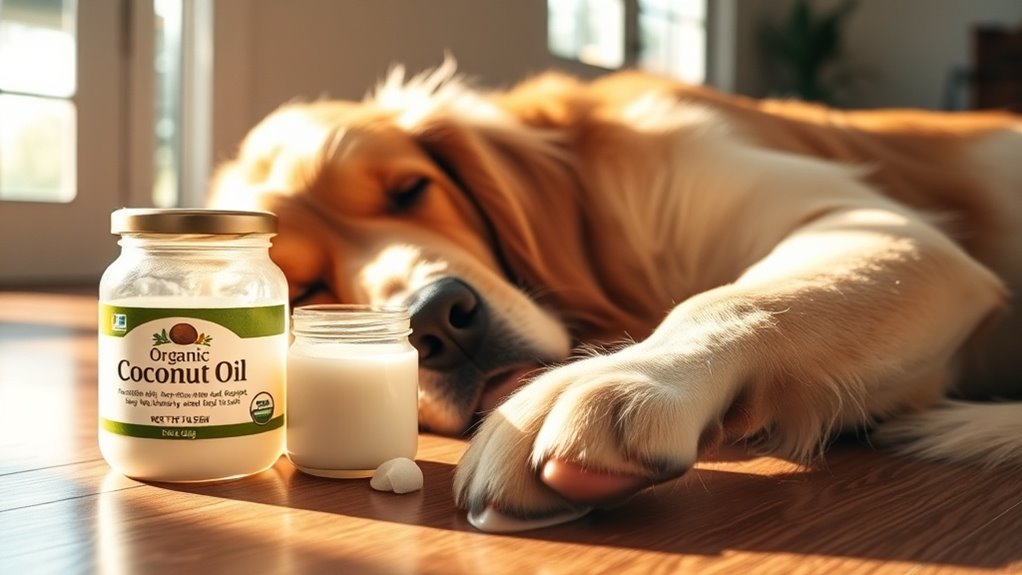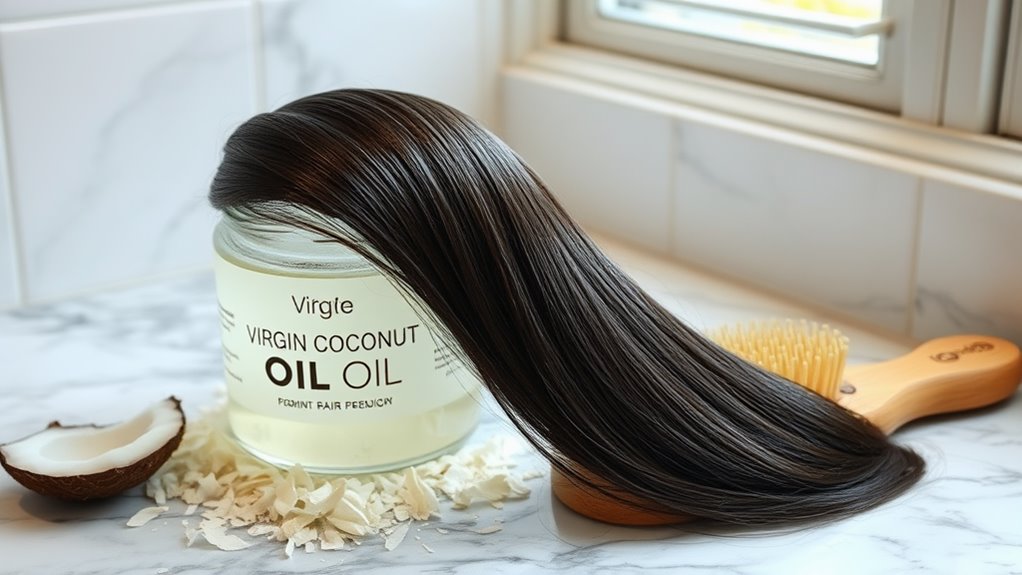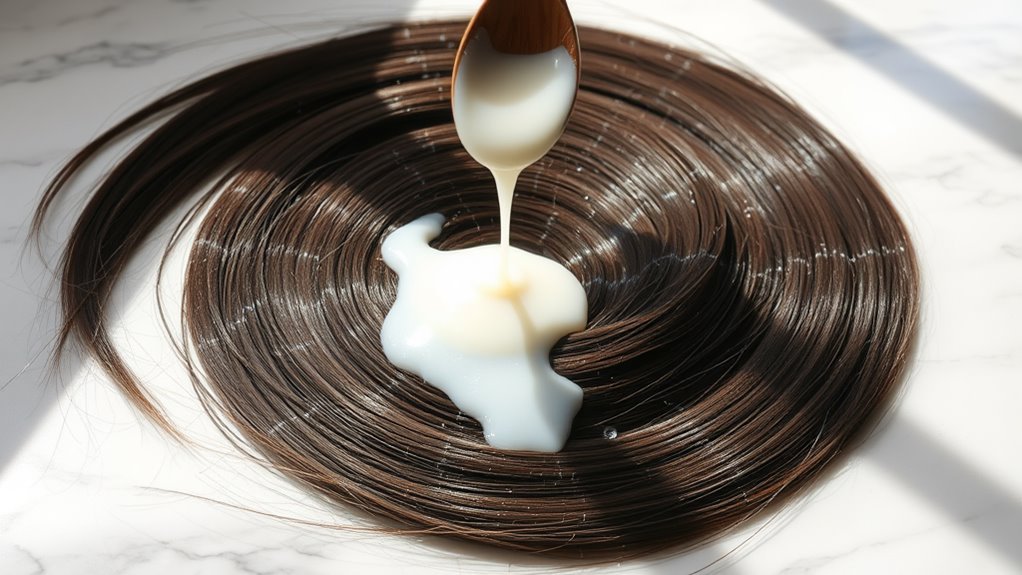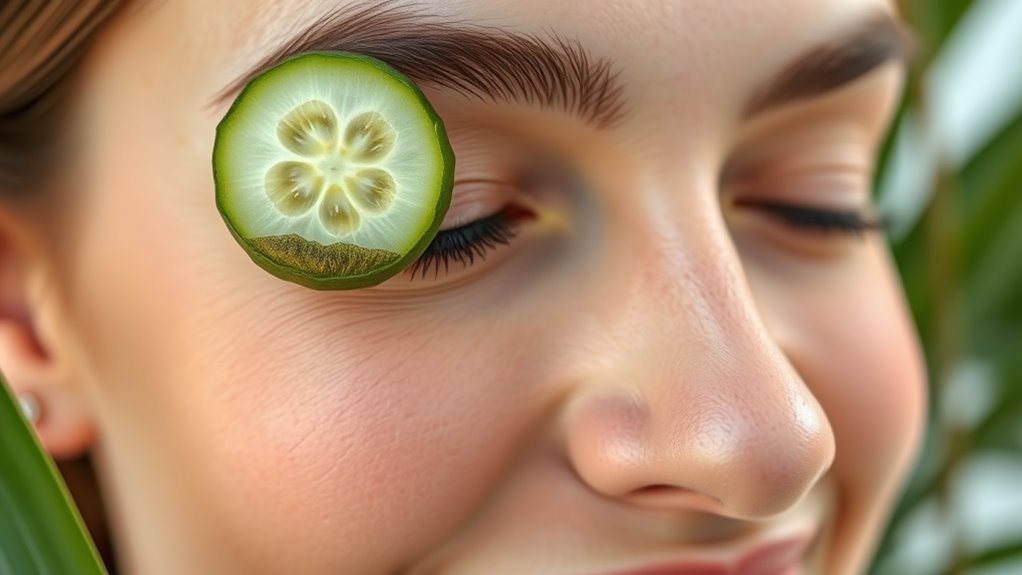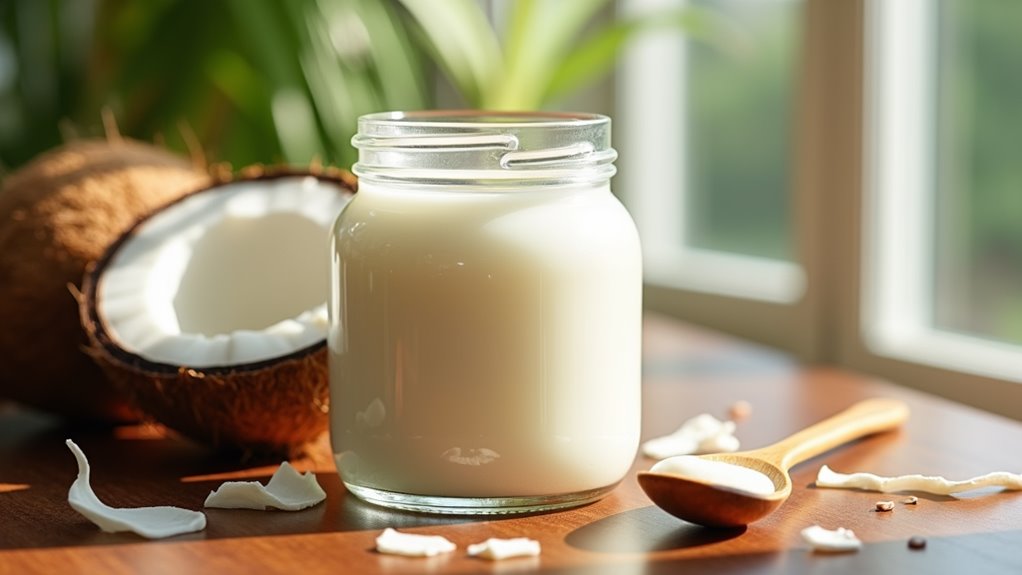How I Use Coconut Oil to Keep My Hair Looking Healthier
To keep your hair looking healthier with coconut oil, opt for virgin, cold-pressed varieties. Warm a few tablespoons and apply it generously from mid-lengths to ends, avoiding the scalp. Let it sit for 20-30 minutes to deeply penetrate and hydrate your strands, then rinse. This nourishing treatment locks in moisture, reduces frizz, and enhances shine, making your hair stronger. Curious about my favorite hair mask recipe and tips for incorporating coconut oil into your routine?
My Journey With Coconut Oil for Hair Care
When I first discovered coconut oil, I was skeptical about the hype surrounding its use for hair care. However, after trying a coconut oil hair mask, I quickly became a believer. The moisturizing properties worked wonders on my dry, damaged strands, leaving them silky and soft. With regular use, I noticed reduced frizz and a shiny finish. Plus, it protected against protein loss from styling, minimizing breakage. I even loved how it supported a healthy scalp, preventing dandruff through its hydrating properties. Incorporating this natural remedy into my routine transformed my hair, proving that coconut oil is indeed a game-changer for hair care. The lauric acid in coconut oil aids in combating fungi, enhancing scalp health and overall hair growth.
Choosing the Right Coconut Oil for Maximum Benefits
Opt for virgin or extra-virgin coconut oil, as these varieties are minimally processed and retain essential nutrients. Cold-pressed options avoid heat treatment, preserving their beneficial properties. Coconut oil’s ability to reduce protein loss makes it particularly advantageous for maintaining healthy hair. Additionally, using medium-chain fatty acids found in coconut oil enhances protection against breakage and helps maintain overall hair health.
Look for organic labels to ensure purity, free from pesticides. Be mindful of your hair type; fine hair may need less, while thick hair can handle more. Finally, steer clear of additives or synthetic fragrances, which could irritate your scalp and counteract coconut oil’s natural goodness.
Preparing My Hair for a Coconut Oil Treatment
Before you start your coconut oil treatment, take a moment to assess your hair’s condition so you can tailor the application for maximum benefits. Gather necessary tools like a brush, comb, and a towel to set yourself up for success, and choose the right timing to ensure the oil has enough time to work its magic. This preparation is essential as coconut oil’s lauric acid provides deep penetration into the hair strands for protection. Additionally, the rich fatty acids in coconut oil create a protective moisture barrier, further enhancing your hair’s health. With everything in place, you’re ready to transform your hair into a healthier, shinier version of itself.
Assessing Hair Condition
How do you ensure your hair is in optimal condition for a coconut oil treatment?
Start by visually assessing your scalp and hair.
Part your hair to check for thinning areas and inspect the hair shaft under natural light for split ends and breakage.
Categorize your hair’s texture and evaluate scalp health for redness or flakes. Hair loss consultations account for 17.5% of all dermatology visits, emphasizing the importance of understanding your hair’s health.
Perform elasticity and tension tests—damp strands should bounce back, and gentle pulls shouldn’t lead to excessive breakage.
Lastly, check porosity by misting—healthy hair should absorb moisture gradually.
This thorough evaluation prepares your hair for the nourishing benefits of coconut oil.
Gather Necessary Tools
What essential tools should you gather to prepare for a coconut oil treatment?
Start with organic or extra-virgin coconut oil for maximum nourishment. Coconut oil is known to improve overall hair condition through moisture and protection. A spray bottle helps moisten your hair beforehand.
Grab a shower cap to trap heat and enhance absorption during the treatment. You’ll also need bowls and mixing tools, like a whisk or spoon, for any additional ingredients.
Don’t forget a towel or T-shirt, in case you don’t have a cap. Finally, ensure you have hair clips ready to section your hair, making application smooth and even, and detangling helps maximize results.
Happy prepping!
Choose the Right Timing
Timing can greatly influence the effectiveness of your coconut oil treatment.
For best results, apply the oil 15 to 30 minutes before you shampoo, protecting your hair from excess water.
If your hair is very dry or porous, consider leaving it on longer—or even overnight for deep conditioning. Just make sure to cover your hair to avoid a mess!
Remember, fine hair benefits from less frequent use, while normal hair stays consistent with regular applications.
The Application Process: How I Use Coconut Oil
When you’re ready to apply coconut oil, start by using it as a pre-shampoo treatment to maximize hydration.
Warm a small amount in your hands, then gently distribute it through the mid-lengths and ends of your hair, avoiding the scalp.
For even better results, consider leaving it in as a conditioning treatment, allowing your locks to soak up all that nourishing goodness. This is especially effective due to coconut oil’s low molecular weight that allows deep penetration into the hair shaft.
Pre-shampoo Treatment Steps
To effectively prepare your hair for a coconut oil pre-shampoo treatment, start by sectioning your hair into 2 to 4 parts.
This ensures even oil distribution and thorough conditioning.
Next, follow these steps:
- Gently detangle your hair to minimize breakage.
- Warm the coconut oil slightly for enhanced absorption.
- Apply the oil from mid-lengths to ends, avoiding the scalp unless dry.
Let the oil sit for 20–30 minutes, wrapping your hair in a warm towel if desired.
Leave-in Conditioning Tips
How can you make the most of coconut oil as a leave-in conditioner? To ensure even distribution and maximize benefits, apply it to damp hair. Start from the ends, working your way up, and use a comb for better detangling. Here’s a quick guide:
| Step | Action Required | Tips |
|---|---|---|
| Apply | Use on damp hair | For even distribution |
| Comb | Detangle with a wide-tooth comb | Prevents knots |
| Style | Proceed with your styling routine | Enhance manageability |
| Adjust Quantity | Tailor based on hair type | Avoid oiliness |
| Daily Use | Consistent application | Maintain moisture |
The Magic of Coconut Oil in Preventing Damage
Why is coconut oil often hailed as a miracle for your hair?
Its unique properties make it a powerful ally against damage.
Consider these benefits:
- Protein Protection: It minimizes protein loss, helping to preserve your hair’s strength.
- Deep Penetration: Its low molecular weight allows coconut oil to penetrate the hair shaft effectively, fortifying from within.
- Protective Barrier: Coconut oil creates a shield on the hair’s surface, guarding against environmental and styling damage. Additionally, it helps achieve a smooth surface that reflects light, enhancing your hair’s natural shine.
Incorporating coconut oil into your hair care routine can lead to healthier, stronger, and more resilient hair, giving you the luscious locks you desire.
Benefits of Coconut Oil for Dandruff and Scalp Health
Coconut oil offers powerful antifungal properties that help keep dandruff at bay while soothing your scalp. Its ability to hydrate effectively restores moisture, tackling dryness and flakiness head-on. Additionally, the antibacterial and anti-inflammatory properties present in coconut oil combat skin irritation, promoting a healthier scalp.
Antifungal Properties Explained
When it comes to tackling dandruff and promoting scalp health, you might be surprised by the powerful antifungal properties of coconut oil.
Here’s what makes it effective:
-
Antimicrobial Action: Lauric acid fights off pesky fungi like Malassezia globosa.
-
Flakiness Reduction: It disrupts fungal biofilms, leading to less itchiness and irritation.
-
Microbiome Balance: Coconut oil supports beneficial bacteria while suppressing harmful pathogens.
Regularly using coconut oil helps maintain a healthy scalp environment, reduces dandruff, and soothes irritation, all while enhancing your hair’s vitality.
Make it part of your routine for optimal benefits!
Scalp Hydration Benefits
The benefits of coconut oil extend beyond its antifungal properties to significantly enhance scalp hydration, making it a powerful ally for anyone dealing with dandruff and dry scalp.
It deeply penetrates your scalp, soothing dryness and reducing flakiness, while nourishing essential lipids restore your skin’s barrier function.
This helps protect against environmental damage and mechanical irritation from styling.
With each application, you’ll feel the calming relief from itchiness and discomfort.
As your scalp remains hydrated and well-maintained, it creates the perfect environment for healthy hair growth, ensuring your strands stay strong and vibrant.
Embrace coconut oil for optimal scalp health!
Dandruff Prevention Strategies
How can you effectively prevent dandruff and maintain a healthy scalp?
Coconut oil holds the key!
Its properties benefit scalp health in multiple ways:
-
Antimicrobial action reduces the growth of Malassezia and other scalp microbes.
-
Anti-inflammatory effects soothe irritation while maintaining moisture, cutting down on flakes.
-
Nutrient delivery strengthens hair and promotes elasticity, leaving your locks soft and shiny.
My Favorite Coconut Oil Hair Mask Recipe
It’s amazing how a simple blend of ingredients can transform your hair, and my favorite coconut oil hair mask is a perfect example.
Start by melting 3 tablespoons of coconut oil until warm.
In a bowl, whisk in 1 tablespoon of honey and 1 egg for added strength and shine.
If your hair craves extra moisture, consider adding half a mashed avocado.
Apply the mask to damp hair, focusing on the ends, and massage your scalp gently.
Cover with a shower cap, letting it work its magic for 30 minutes.
Coconut oil creates a protective barrier against humidity, which helps to reduce frizz.
Rinse with lukewarm water, shampoo, and enjoy your revitalized locks!
Tips for Storing and Maintaining Coconut Oil
After enjoying the benefits of your homemade coconut oil hair mask, you’ll want to ensure your coconut oil stays fresh and effective for future use.
Here are three key tips for proper storage:
- Choose the Right Container: Opt for glass or food-grade plastic, ensuring it’s airtight and non-reactive to keep the oil stable.
- Store in a Cool, Dark Place: Keep it below 76°F (24°C) and away from sunlight or heat sources.
- Avoid Contamination: Use clean, dry utensils to scoop oil, preventing moisture or odor absorption.
Following these guidelines helps maintain your coconut oil’s quality and enhances its benefits!
Observing Changes: My Hair Transformation
Seeing the changes in my hair since I started using coconut oil has been nothing short of remarkable. You’ll notice the shine and softness right away, and the reduction in frizz makes styling a breeze. With each application, your hair’s texture becomes smoother, and you’ll even observe fewer split ends over time. Additionally, the antimicrobial properties of coconut oil help combat issues like dandruff, contributing to a healthier scalp.
| Benefit | Before Coconut Oil | After Coconut Oil |
|---|---|---|
| Shine | Dull and lifeless | Bright and vibrant |
| Frizz | Unruly and wild | Sleek and manageable |
| Split Ends | Frequent and noticeable | Rare and barely visible |
| Overall Health | Brittle and weak | Strong and resilient |
Incorporating Coconut Oil Into My Regular Routine
Regularly incorporating coconut oil into your hair care routine can yield transformative results. To get started, try these effective methods:
- Pre-wash treatment: Apply warmed oil 20–30 minutes before washing to combat dryness.
- Leave-in conditioner: Use a pea-sized amount on damp hair to tame frizz.
- Scalp massage: Massage into your scalp to stimulate circulation.
Tailor your routine to your hair type; fine hair may need less, while thick or curly locks benefit from more frequent applications.

